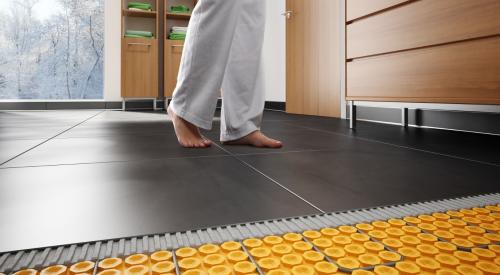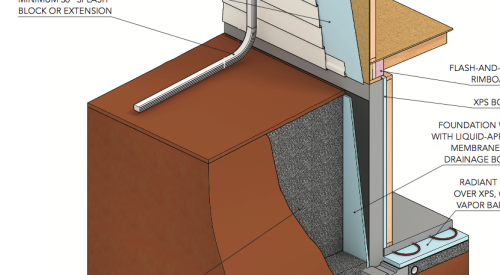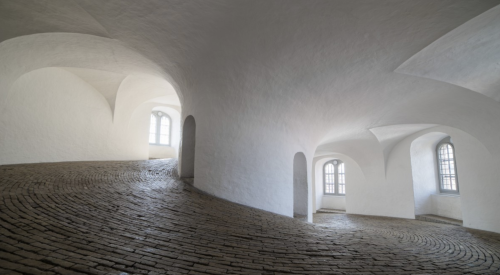 NuHeat's electrically conductive plastic mats are applied to the subfloor. |
However, failures in a piping system in the 1980s and 1990s threw doubt on the soundness of hydronic heat systems. In response, radiant floor systems, such as NuHeat, stepped up marketing efforts, touting the option as a safe, reliable and simple solution to keep floors nice and toasty.
"The NuHeat system was invented in the late 1980s as a 3 by 2 heating mat of sorts," says John Rose, president of NuHeat. The original inspiration, interestingly, had nothing to do with flooring. "The idea was for secretaries at their desks to keep their feet warm. The mats weren't very attractive, and it didn't do well," he admits.
Water WorksRose says his friend, John Ames, owner of Ames Tile & Stone, saw the NuHeat system as an answer to one of the only complaints he had with hard surfaces — namely how cold they are to walk on. He bought the company and put together an outside board of directors back in 1991 to solve the problem. "Then the original problem facing us was how to market the product," says Rose.
Several high-profile lawsuits against some Denver-area installers and the Goodyear Tire Corp. had a significant impact on the business. "The blemish on the industry ... was that there was a series of lawsuits against hot water radiant system manufacturers in the late 80s or early 90s. Goodyear Tire made tubing for a number of manufacturers that were putting in the hydronic system, and unfortunately they changed the formula of the rubber tubing and it broke down over time. And unfortunately, many of those systems were the sole source of heating in that house," Rose says.
Despite the checkered past of radiant flooring, several key markets, mainly in Minneapolis and pockets in the Midwest and Chicago, have seen growth in radiant flooring. "Ease of installation and simplicity is what builders and remodelers want on a job site. After all, contractors hate callbacks. That's why NuHeat caught on," says Rose.
How it WorksElectric radiant floors, also known as dry installations, typically comprise electric cables built into the floor. Systems like NuHeat feature mats of electrically conductive plastic and are mounted onto the subfloor below a floor covering such as tile. The NuHeat system is thin — pre-built like an electric blanket that's divided into sections and wired to a central location.
Because of the relatively high cost of electricity, electric radiant floors are usually only cost-effective if they include a significant thermal mass, such as a thick concrete floor, and if the utility company offers time-of-use rates, which allows radiant systems to "charge" the flooring with heat during off-peak hours. The heat stored in it will keep the house comfortable for hours without any additional electrical input. The system, however, only draws 12 watts per square foot at full power consumption and pulses on to maintain the temperature the homeowner set. An Energy Star-rated thermostat and a ground-fault circuit integrate to prevent electrical fires.
Industry ChallengesSafety is a major concern for homeowners. "They ask us, 'Am I going to get an electrical shock?' That was a major obstacle when we launched this in the mid 1990s," Rose says.
Although Joe Rutkowski, owner of Custom Tile and Marble Installations out of Lemont, Ill. now uses radiant floor heating particularly because it's easy to install, he didn't always think so highly of the product. "I actually steered people away from heated floors because of my earlier experiences," says Rutkowski.
With other radiant flooring offerings in the past, many customers complained the heat was "spotty," he says. "We had one customer who called and told us she felt the floor was unbearably hot near the sink, and if she went over by the stove, it wasn't even hot at all." Installation errors and the difficulty of working with roll systems kept Rutkowski away from other products. "It concentrates on the floor. You don't put it where you don't need it," says Rutkowski. "It works different than hydronic systems or heating roll mats, where you have to nail down brackets and snake the wiring in an S-pattern. Then you're gaining 516 of an inch in floor. You have to pour self-leveling concrete there, and that eats up the concrete like you wouldn't believe."
The system seems to work best under thin ceramic and porcelain tile. "Interestingly, if you put it under slate, people say it makes the slate feel soft. Limestone and marble work well, too," Rose says.
The product comes with a 25-year warranty. "And we stick with it," says Rose. "Our job is to be there to support the builder and make sure it's an easy installation. Once people have had it, they can't live without it."











